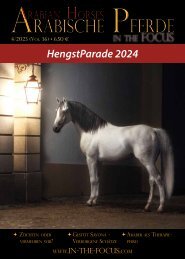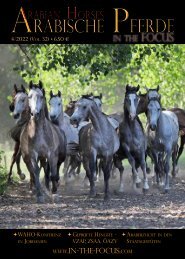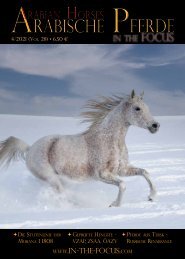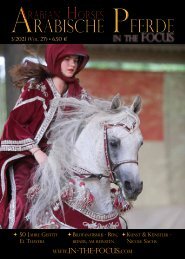Arabische Pferde IN THE FOCUS 1/2023 (Vol. 33) - public
Zeitschrift für Liebhaber und Züchter arabischer Pferde
Zeitschrift für Liebhaber und Züchter arabischer Pferde
Erfolgreiche ePaper selbst erstellen
Machen Sie aus Ihren PDF Publikationen ein blätterbares Flipbook mit unserer einzigartigen Google optimierten e-Paper Software.
STATE STUDS -<br />
WAHO CONFERENCE 2022 - PRESENTATION (III)<br />
PAST - PRESENT - FUTURE (III)<br />
In this third part of the presentations shown at the recent WAHO conference in Jordan,<br />
Deirdre Hyde provides a comprehensive overview of the studs and stables of the Ottoman,<br />
Mughal and Safavid Empires. In a fourth part we will also present the Royal Studs in the<br />
Middle East, the remount and state studs in Australia and America, their history and<br />
development.<br />
Zucht<br />
Seide, Edelsteine, Teppiche und Gewürze im Tausch gegen <strong>Pferde</strong>. Es<br />
überrascht nicht, dass Sultane und Kaiser riesige Ställe unterhielten<br />
und großes Interesse an ihren persönlichen <strong>Pferde</strong>zuchten zeigten.<br />
Die ersten königlichen Gestüte sorgten auch dafür, dass ihre Regierungen<br />
eine große Kavallerie unterhielten.<br />
DAS MOGULREICH<br />
Das Mogulreich bestand in Indien bis 1707, als es der Macht der Britischen<br />
Ostindien-Kompanie zum Opfer fiel. Seine Kavallerie war die<br />
Hauptstütze seiner Macht, etwas, das gerade Kaiser Akbar der Große<br />
sehr wohl verstanden hatte. Er hatte angeblich 12.000 <strong>Pferde</strong> in seinen<br />
königlichen Stallungen und seine Vorliebe galt den arabischen<br />
<strong>THE</strong> MUGHAL EMPIRE<br />
The Mughal Empire held sway in India until 1707 when it fell to the might<br />
of the British East India Company. Its cavalry had been the mainstay of its<br />
power, as was well understood by Emperor Akbar the Great, who is said<br />
to have had 12,000 horses in his own Royal Stable, his preference was for<br />
Arabian and Persian horses.<br />
Nevertheless, horses were essential in all walks of life, and during the 19th<br />
Century, Bombay was considered one of the greatest and best markets<br />
for Arabian horses. It was recorded that in a six-month period around<br />
3000 horses were received from the Gulf Ports and from these stud horses<br />
were selected for the whole of India where government stables attempted<br />
to breed remounts.<br />
Abstainer *1922, Hengst im Remontegestüt Ahmednagar<br />
Abstainer *1922, Stallion at the Remount Stud Ahmednagar<br />
Silver Thrush *1921, ein Desertbred, ebenfalls in Ahmednagar.<br />
Silver Thrush *1921, a Desertbred, also at Ahmednagar.<br />
und persischen <strong>Pferde</strong>n.<br />
Damals waren <strong>Pferde</strong> in allen Lebensbereichen unverzichtbar, und im<br />
19. Jahrhundert galt Bombay als einer der größten und besten Märkte<br />
für arabische <strong>Pferde</strong>. Man kann nachlesen, dass in einem Zeitraum<br />
von sechs Monaten etwa 3000 <strong>Pferde</strong> aus den Häfen des persischen<br />
Golfs kamen und von diesen <strong>Pferde</strong>n wurden die Zuchtpferde für<br />
ganz Indien ausgewählt, mit denen man dann in Staatsgestüten versuchte,<br />
Remonten zu züchten.<br />
Brigadier W. H. Anderson, früherer Sekretär der Arab Horse Society<br />
und ehemaliger Direktor der Remonteabteilung in Indien, schrieb<br />
1936 in einem Artikel für das Journal of the Arab Horse Society, dass<br />
1902 ein Remonte-Gestüt in Ahmednagar in der Provinz Marashtra<br />
neu eröffnet wurde. Das einzige Gestüt, das sich der Zucht reiner<br />
1/<strong>2023</strong> - www.in-the-focus.com<br />
29<br />
Brigadier W. H. Anderson, an early Secretary of the Arab Horse Society<br />
and one time Director of Remounts in India, wrote in an article for the<br />
1936 Journal of the Arab Horse Society that in 1902 a Remount Stud was<br />
restarted at Ahmednagar, in the Marashtra Province, the only stud devoted<br />
to breeding pure Arabians in substantial numbers. These horses were<br />
considered superior to the imported desert horses. The foundation sires<br />
at Ahmednagar included two stallions from Crabbet: Mareukh (Mesaoud<br />
/ Nefisa) and Rashid (Mesaoud / Rose of Sharon) along with others from<br />
the racecourses of Poona and Bombay. One such stallion, Silver Thrush,<br />
1921, a desert bred, winner of 9 races was considered exceptional with<br />
great substance, beauty and quality. He covered a desert bred mare,<br />
Amsha also from Ahmednagar, the result, a filly Nightingale, has a line<br />
still going in South Africa.














